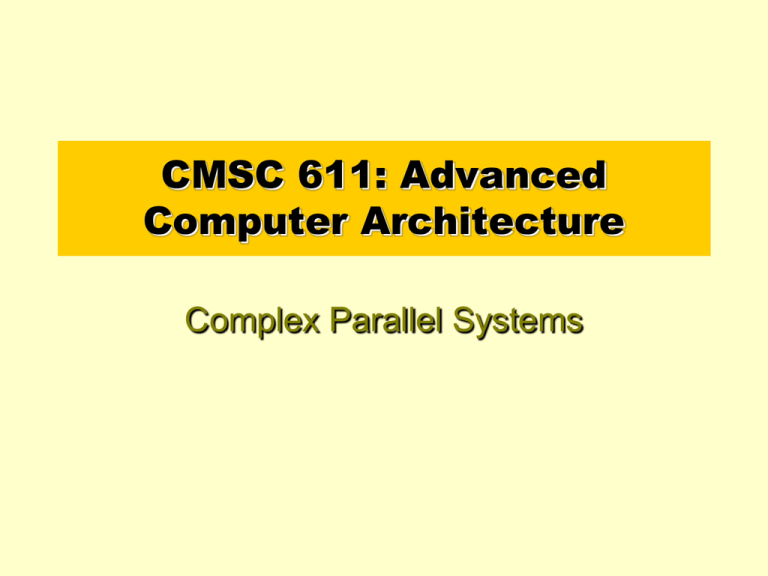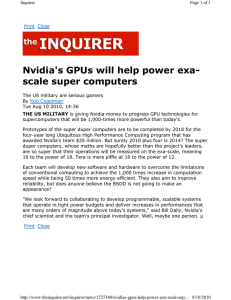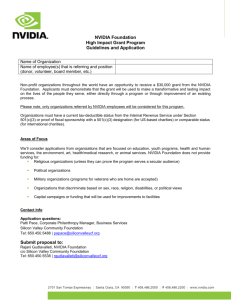CMSC 611: Advanced Computer Architecture Complex Parallel Systems
advertisement

CMSC 611: Advanced Computer Architecture Complex Parallel Systems Computational Examples • Connection Machine 5 • SGI Origin • Intel Nehalem Thinking Machines CM5 (1993) • MIMD, SPARC processors • Fat Tree communication network Processor Data Link Single Routing Node Virtual Node Routing Node D. Hillis and L. Tucker, “The CM-5 Connection Machine: A Scalable Supercomputer,” Communications of the ACM, v36n11, November 1993 SGI Origin (1998) • MIPS R10000 processor • Hypercube connected • ccNUMA / directory protocol SGI Origin Node Ammon, "Hypercube Connectivity within ccNUMA Architecture", Silicon Graphics, 1998. Origin Communication Level Latency (ns) L1 cache 5.1 L2 cache 56.4 local memory 310 4P remote memory 540 8P avg. remote memory 707 16P avg. remote memory 726 32P avg. remote memory 773 64P avg. remote memory 867 128P avg. remote memory 945 Laudon and Lenoski, "SGI Origin: A ccNUMA Highly Scalable Server", Proceedings of Computer Architecture 1997 Intel Nehalem Design Appaloosa, “Intel Nehalem Microarchitecture”, Wikimedia project, November 2008 Communication Performance Michael Thomadakis: The Architecture of the Nehalem Processor and Nehalem-EP SMP Platforms Graphics Hardware • • • • • • • Problem domain Pixel-Planes 4 Pixel-Planes 5 SGI Reality Engine Pixel Flow NVIDIA GeForce 6 NVIDIA Maxwell Graphics Rendering • Just model the surfaces – (that’s all you can see) • Approximate them with a mesh of triangles • Get really good at rendering triangles Graphics Pipeline • Transform: find where each vertex goes on the screen Transform Clip Rasterize Shade Visibility/Blend Display Graphics Pipeline • Clip: get rid of offscreen parts (especially behind the viewer) Transform Clip Rasterize Shade Visibility/Blend Display Graphics Pipeline • Rasterize: find which pixels are inside the triangle Transform Clip Rasterize Shade Visibility/Blend Display Graphics Pipeline • Shade: compute the color for each pixel Transform Clip Rasterize Shade Visibility/Blend Display Graphics Pipeline • Visibility: throw out pixels covered by opaque stuff that’s already rendered • Blend: Combine colors for partially transparent objects Transform Clip Rasterize Shade Visibility/Blend Display Graphics Pipeline • Display: Show results to user Transform Clip Rasterize Shade Visibility/Blend Display Graphics Pipeline vertex Transform Clip triangle Rasterize Shade pixel Visibility/Blend frame Display Computation and Bandwidth Based on: • 100 Mtri/sec (1.6M/frame @ 60Hz) • 256 Bytes vertex data • 128 Bytes interpolated • 68 Bytes pixel output • 5x depth complexity 75 GB/s • 16 4-Byte textures • 223 ops/vertex • 1664 ops/pixel • No caching 13 GB/s • No compression 335 GB/s Texture 45 GB/s Fragment Vertex 67 GFLOPS Triangle Pixel 1.1 TFLOPS UNC Pixel-Planes 4 (1985) • DSP vertex processor • Custom rasterizer • 512x512 SIMD array – Full screen Fuchs et al., ”Fast spheres, shadows, textures, transparencies, and image enhancements in pixel-planes", SIGGRAPH 1985 UNC Pixel-Planes 5 (1989) • ~40 i860 CPUs for vertex processing • ~20 128x128 SIMD arrays for pixel processing Fuchs et al., ”Pixel-Planes 5: a heterogeneous multiprocessor graphics system using processor enhanced memory", SIGGRAPH 1989 SGI Reality Engine (1993) Akeley, ”Reality Engine Graphics", SIGGRAPH 1993 Pixel-Flow (1992-1997) • ~35 nodes, each with – 2 HP-PA 8000 CPUs – 128x64 SIMD array (~160 tiles/screen) Eyles, et al., "PixelFlow: The Realization", Graphics Hardware 1997 Pixel-Flow Eyles, et al., "PixelFlow: The Realization", Graphics Hardware 1997 NVIDIA GeForce 6 (2004) Kilgariff and Fernando, ”The GeForce 6 GPU Architecture", GPU Gems 2, 2005 GeForce 6 Parallelism Data Parallel Vertex More Parallel … Triangle Pixel Pipeline More Parallel More Pipeline NVIDIA G80/Tesla (2006) NVIDIA, “NVIDIA GeForce 8800 GPU Architecture Overview”, TB-02787-001_v01, November 2006 NVIDIA Maxwell (2014) NVIDIA, NVIDIA GeForce GTX 980 Whitepaper, 2014 Maxwell SIMD Processing Block • 32 Cores • 8 Special Function • NVIDIA Terminology: – Warp = interleaved threads • Hide memory latency • Want at least 4-8 – Thread Block = Warps*Cores • Flexible Registers – Trade registers for warps NVIDIA, NVIDIA GeForce GTX 980 Whitepaper, 2014 Maxwell Streaming Multiprocessor (SMM) • • • • 4 SIMD blocks Share L1 Caches Share memory Share tessellation HW NVIDIA, NVIDIA GeForce GTX 980 Whitepaper, 2014 Maxwell Graphics Processing Cluster • 4 SMM • Share rasterizer NVIDIA, NVIDIA GeForce GTX 980 Whitepaper, 2014 Full Maxwell (again) NVIDIA, NVIDIA GeForce GTX 980 Whitepaper, 2014


